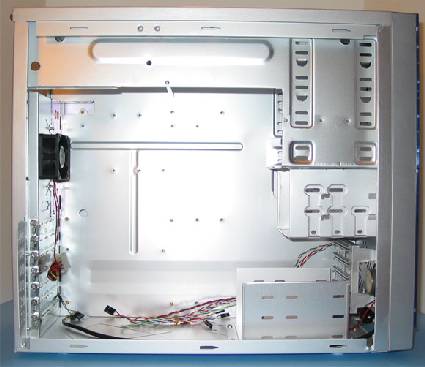The Lazy Days of Summer Case Review
Raidmax Galaxy-988, Continued
At first glance, the Raidmax Galaxy-988 doesn't look bad. It is a silver colored, aluminum chassis with a thin, 1/8", blue tinted piece of acrylic bolted to the front of the case. Weighing in at slightly less than 15 pounds without a power supply, there is not much to this case. This case is meant for integrators who are trying to achieve a specific price point, and nothing more. The majority of the features that we have come to expect are missing from the Raidmax Galaxy-988. It is no wonder that Raidmax primarily targets this case toward integrators who are looking to save a few dollars.
A look at the inside of the Galaxy-988.
Although this case is lightweight, the acrylic that is bolted to the front of the case helps to strengthen the Galaxy-988 so that there is limited bend and twist to the case. This is further reinforced by a small metal rod that extends the length of the case interior from just under the power supply to the motherboard tray. This helps provide cross structural rigidity. Once we removed this cross member, the amount of twist and flex to the case increased greatly. Raidmax obviously knows this, thus the included rod for improved stability.
All kidding aside, the edges of the case are seamed and rolled over to prevent cuts to the user; however, some of the edges are a little sharp in some areas. All of the drive cages use a hollow type of riveting that is not quite as fancy or secure as we have seen on other, more expensive, cases. Both the 3-" drive bay for the floppy, and what is best described as an inverted hard drive mounting bracket can be removed by taking out a few screws. The hard drive mounting bracket located and bolted to the bottom of the case is flimsy and as bendable as a soda pop can. This doesn't speak well for the thickness of the aluminum used on the interior of the Galaxy 988; just by applying a small amount of pressure, we were almost able to fold over this hard drive cage at the bottom of the case. The location of the hard drive cage in the bottom of the case is also questionable. If you are using a larger ATX board you might have some difficulties connecting the drives to the motherboard, depending on the location and orientation of said connectors on the motherboard. The case does feature some possible channels that could be used to hide some of the unsightly cabling, but this will still be difficult due to the cramped space inside the Galaxy-988.
Get Tom's Hardware's best news and in-depth reviews, straight to your inbox.
Current page: Raidmax Galaxy-988, Continued
Prev Page Raidmax Galaxy-988 Next Page Raidmax Galaxy-988, Continued